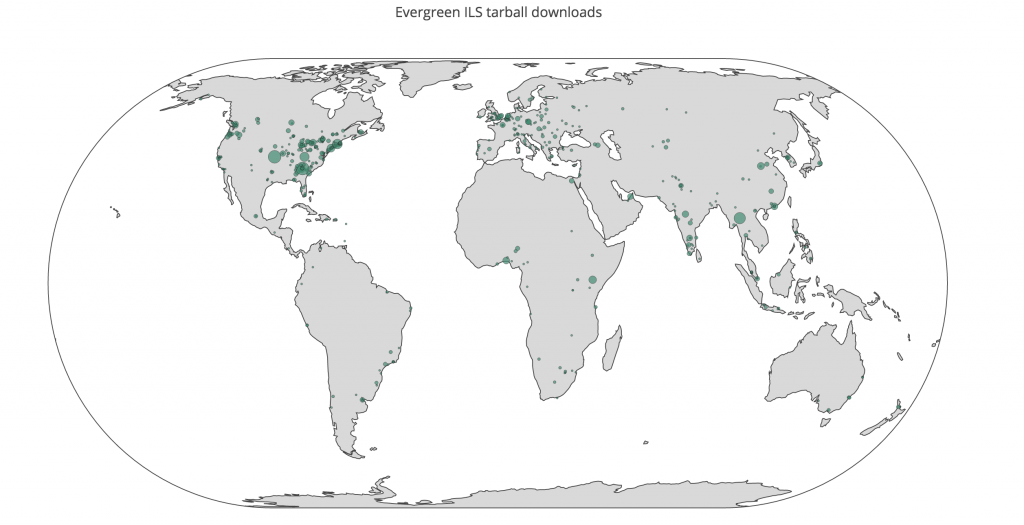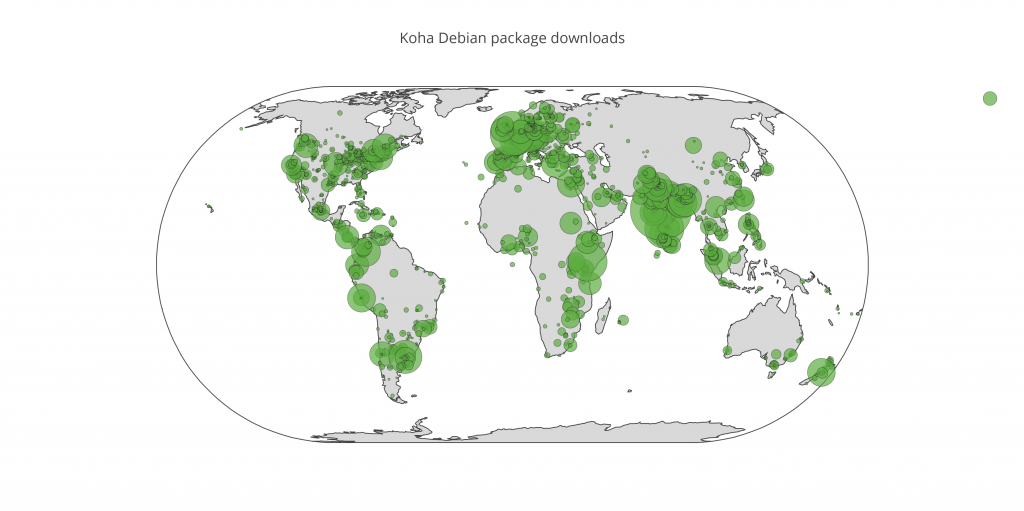One of the beautiful things about Code4Lib qua banner is that it can be easily taken up by anyway without asking permission.
If I wanted to, I could have lunch with a colleague, talk about Evergreen, and call it a Code4Lib meetup, and nobody could gainsay me — particularly if I wrote up a summary of what we talked about.
Three folks in a coffeehouse spending an afternoon hacking together a connection between digital repository Foo and automatic image metadata extractor Bar, then tossing something up on the Code4Lib Wiki? Easy-peasy.
Ten people for dinner and plotting to take over the world replace MARC once and for all? Probably should make a reservation at the restaurant.
Afternoon workshop for 20 in your metro area? Well, most libraries have meeting rooms, integral classrooms, or computer labs— and directors willing to let them be used for the occasional professional development activity.
Day and a half conference for 60 from your state, province, or region? That’s probably a bit more than you can pull off single-handedly, and you may well simply not have the space for it if you work for a small public library. You at least need to think about how folks will get meals and find overnight accommodations.
The big one? The one that nowadays attracts over four hundred people from across the U.S. and Canada, with a good sprinkling of folks from outside North America — and expects that for a good chunk of the time, they’ll all be sitting in the same room? And that also expects that at least half of them will spend a day scattered across ten or twenty rooms for pre-conference workshops? That folks unable to be there in person expect to live-stream? That tries in more and more ways tries to lower barriers to attending it?
Different kettle of fish entirely.
The 2017 conference incurred a tick under $240,000 in expenses. The 2016 conference: a bit over $207,000. This year? At the moment, projected expenses are in the neighborhood of $260,000.
What is this going towards? Convention center or hotel conference space rental and catering (which typically need to be negotiated together, as guaranteeing enough catering revenue and/or hotel nights often translates into “free” room rental). A/V services, including projectors, sound systems, and microphones. Catering and space rental for the reception. For the past few years, the services of a professional event management firm — even with 50+ people volunteering for Code4Lib conference committees, we need the professionals as well. Diversity scholarships, including travel expenses, forgone registration fees, and hotel nights. T-shirts. Gratuities. Live transcription services.
How is this all getting paid for? Last year, 49% of the income came from conference and pre-conference registrations, 31% from sponsorships and exhibitor tables, 5% from donations and sponsorships for scholarships, and 3% from hotel rebates and room credits.
The other 12%? That came from the organizers of the 2016 conference in Philadelphia, who passed along a bit under $33,000 to the 2017 LPC. The 2017 conference in turn was able to pass along a bit over $25,000 to the organizers of the forthcoming 2018 conference.
In other words, the 2017 conference effectively operated at a loss of a bit under $8,000, although fortunately there was enough of a cushion that from UCLA’s perspective, the whole thing was a wash — if you ignore some things. Things like the time that UCLA staff who were members of the 2017 local planning committee spent on the whole effort — and time spent by administrative staff in UCLA’s business office.
What are their names? I have no clue.
But something I can say much more confidently: every member of the 2017 LPC and budget committees lost sleep pondering what might happen if things went wrong. If we didn’t get enough sponsorships. If members of the community would balk at the registration fee — or simply be unable to afford it — and we couldn’t meet our hotel room night commitments.
I can also say, without direct knowledge this time, but equally confidently, that members of the 2016 organizers lost sleep. And 2015. And so on down the line.
While to my knowledge no Code4Lib member has ever been personally liable for the hotel contracts, I leave it to folks to consider the reputational consequence of telling their employer, were a conference to fail, that that institution is on the hook for potentially tens of thousands of dollars.
Of course, somebody could justly respond by citing an ancient joke. You know, the one that begins like this: “Doctor, it hurts when I do this!”.
And that’s a fair point. It is both a strength and weakness of Code4Lib that it imposes no requirement that anybody do anything in particular. We don’t have to have a big annual conference; a lot of good can be done under the Code4Lib banner via electronic communications and in-person meetups small enough that it’s of little consequence if nobody happens to show up.
But I also remember the days when the Code4Lib conference would open registration, then close it a couple hours later because capacity has been reached. Based on the attendance trends, we know that we can reasonably count on at least 400 people being willing to travel to attend the annual conference. If a future LPC manages to make the cost of attending the conference signficantly lower, I could easily see 500 or 600 people showing up (although I would then wonder if we might hit some limits on how large a single-track conference can be and still remain relevant for all of the attendees),
I think there is value in trying to put on a conference that brings in as many practitioners (and yes, managers) in the GLAM technology space together in person as can come while also supporting online participation — but puts control of the program in the hands of the attendees via a process that both honors democracy and invites diversity of background and viewpoint.
Maybe you agree with that—and maybe you don’t. But even if you don’t agree, please do acknowledge the astonishing generosity of the people and institutions that have put their money and reputation on the line to host the annual conference over the years.
Regardless, if Code4Lib is to continue to hold a large annual conference while not being completely dependent on the good graces of a small set of libraries that are in a position to assume $250,000+ liabilities, the status quo is not sustainable.
That brings me to the Fiscal Continuity Interest Group, which I have helped lead. If you care about the big annual conference, please read the report (and if you’re pressed for time, start with the summary of options), then vote. You have until 23:59 ET on Friday, November 3 to respond to the survey.
The survey offers the following options:
- maintain the status quo, meaning that each potential conference host is ultimately responsible for deciding how the liability of holding the conference should be managed
- set up a non-profit organization
- pick among four institutions that have generously offered to consider acting as ongoing fiscal sponsors for the annual conference
I believe that moving away from the status quo will help ensure that the big annual Code4Lib conference can keep happening while broadening the number of institutions that would be able to physically host it. Setting up some kind of ongoing fiscal existence for Code4Lib may also solve some problems for the folks who have been running the Code4Lib Journal.
I also believe that continuing with the status quo necessarily means that the Code4Lib community must rethink the annual conference: whether to keep having it at all; to accept the fact that only a few institutions are nowadays capable of hosting it at the scale we’re accustomed to; and to accept that if an institution is nonetheless willing to host it, that we should scale back expectations that the community is entitled to direct the shape of the conference once a host has been selected.
In other words, it boils down to deciding how we wish to govern ourselves. This doesn’t mean that Code4Lib needs to embrace bureaucracy… but we must either accept some ongoing structure or scale back.
Choose wisely.


